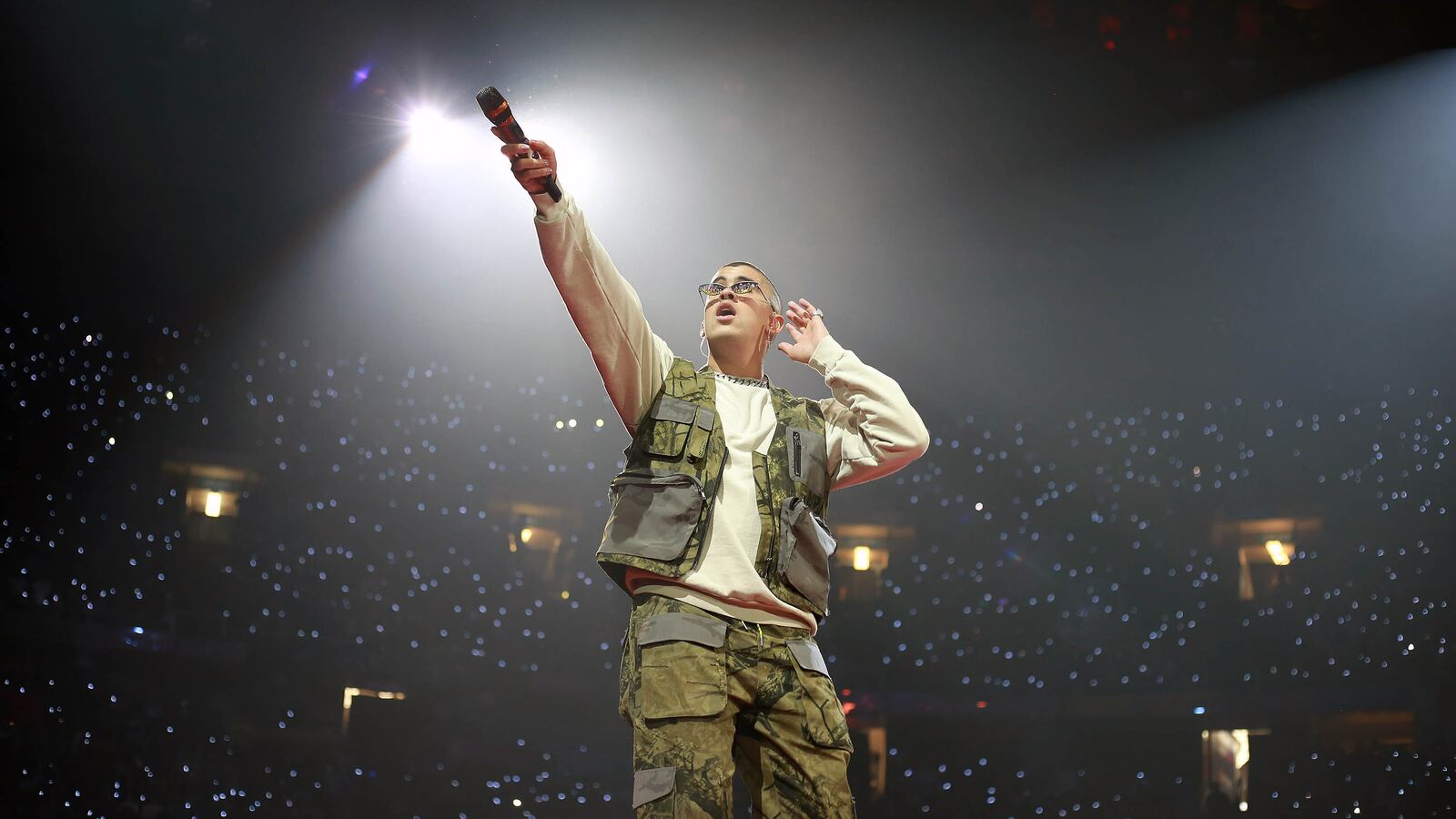Music fans are used to waiting.
Fiona Apple took eight years to give us Fetch the Bolt Cutters. Frank Ocean has been radio silent since 2016’s Blonde. Rihanna gave us lingerie, makeup and luxury clothing lines, but we’re still waiting on her next lineup of songs. And guess how old Adele is now? She’s 32. But 32, the album, is nowhere to be found. That’s fine. Because there’s one rising superstar who has never kept us waiting long.
Enter Benito Antonio Martínez Ocasio. The 26-year-old Puerto Rican star, famously known as Bad Bunny, dropped his third whole-ass album of 2020 at midnight on Thanksgiving. It’s an apt date, given his adoring fans are thankful for the steady stream of content in a year full of uncertainty, isolation, and loss.
The album is titled El Último Tour del Mundo but the Latin trap king reassured us this is not literally his last tour—and how could it be, considering the exponential rate at which his career is ascending? Bad Bunny’s music, performed entirely in Spanish (a language that I, regrettably, do not speak), has broken through to English-speaking audiences. That’s a feat in itself: El Último Tour del Mundo debuted at No. 1 on Billboard’s 200 and is the first all-Spanish album to do so.
Bad Bunny’s latest album reveals his most experimental music yet, in line with his reggaeton and trap roots but drawing unabashedly from elements of rock and electronic music. While the blends may feel new for fans of the Latin star, he has always expressed a desire to widen his musical spectrum. And genre-bending is entirely in line with the mission driving his persona: to break free of the limits imposed on him—by music, by fashion, by people, by norms—and stay true to himself.
Take “Maldita Pobreza,” which starts off with a solemn acoustic intro before diving into an upbeat alt-rock chorus raising a fist at poverty, or his ’90s rock-inspired anthem “Yo Visto Así,” another middle finger to the naysayers who criticize his fashion sense and speculate about his sexuality. “No me importa,” he sings, “no me importa.”
For those who have followed Bad Bunny since his SoundCloud days, when he emo-rapped to “Soy Peor” and “Amorfoda,” the newer tracks may recall the novelty of Kanye releasing his auto-tuned pop ballad “Heartless” in 2008 (which we all now know every damn lyric to) or even Lil Wayne’s rap-rock number “Prom Queen”—both on the heels of their highly acclaimed, more traditional rap albums.
But Bad Bunny has hinted at departures from his signature sound before, including on his 2018 debut album X 100PRE: just look at the EDM-infused beat on his Diplo collab “200 MPH” or the punk influence on “Tenemos Que Hablar.” If a Buzzfeed video of Bad Bunny petting bunnies is what first captured my heart, that love burns even brighter imagining el Conejo Malo quarantine-jamming to Nirvana and Jimmy Eat World and finding inspiration for his latest angst-rock inclinations.
My personal favorite from El Último Tour, “Antes Que Se Acabe,” pays tribute to Puerto Rico’s late astrologer legend, Walter Mercado, whose iconic sign-off is heard in the beginning: “Y que reciban de mí siempre paz, mucha paz, pero sobre todo mucho, mucho, mucho, mucho…” For lovers of house music, a genre with the fluidity to cross over easily into other musical styles, “Antes Que Se Acabe” is a hybrid track reminiscent of hits from Flume, or Louis the Child. Most of all it’s a sequel to Bad Bunny’s own “Estamos Bien,” a dedication to his homeland after the devastation of Hurricane Maria, telling the rest of us gringos that, yeah, we’re good.
Then there’s the dreamy space-like acoustics of his romantic ballad to the stars, “Trellas,” and a throwback to ’80s pop (or is it ’90s hip-hop?) on “Sorry Papi” featuring R&B diva Abra, followed by a retro, New Wave-styled intro on “120” which could be mistaken for something by The Weeknd.
Not to worry, as you can still find the old (more mainstream) Benito talking dirty on “Te Mudaste” or on the fiercely self-confident “Booker T” where he tells us how it is: “Estoy en mi peak.”
Over and over again, the 26-year-old has given us the soundtrack to 2020 from his home in Puerto Rico. “Maldito año nuevo,” am I right? It’s a standout line from his bossa nova track “Si Veo A Tu Mamá” which opens up his reggaeton album, YHLQMDLG (Yo Hago Lo Que Me Da La Gana, which translates to “I Do Whatever I Want”), his third studio album released earlier this year. I was standing outside a Havana-themed salsa club in the middle of old town Cartagena, Colombia on the very last night of a solo birthday trip when the album dropped on February 29th at midnight. The next morning I heard “hoy se bebe, hoy se gasta” blaring from car stereos on the way to the airport. Meanwhile, when parts of the U.S. went into a COVID-19 lockdown only two weeks later, his dance hit “Yo Perreo Sola” took on a whole new meaning.
He followed up YHLQMDLG with a quarantine compilation album, dropped spontaneously in May, called Las Que No Iban a Salir and led by the single “En Casita” (you can probably guess why) featuring his girlfriend Gabriela. It featured music recorded during quarantine and some that didn’t make the final cut on his previous solo albums that, perhaps fueled by the restlessness and loneliness of the pandemic, he decided to release anyway. Bad Bunny said it best: he does what he wants.
The latest in a monumental production of three albums in one year, El Último Tour del Mundo is also Bad Bunny’s fifth album in—let this sink in—less than two years. His debut was released on Christmas Eve 2018, while his follow-up Oasis, a joint effort with Colombian reggaeton star J Balvin, was released six months later. And that doesn’t include the music he’s collaborated on or put out separately in 2020, from “Un Dia” with J Balvin, Dua Lipa, and Tainy, or PARTYNEXDOOR’s “LOYAL” remix feat. him and Drake. There’s a laundry list of collaboration tracks he’s churned out since his breakout year in 2018, with features from Cardi B, Ricky Martin, Daddy Yankee, Ñengo Flow, Jowell y Randy, Ozuna, Enrique Iglesias, Maluma, Karol G, Rosalía, Will Smith (yes, the Prince of Bel-Air himself), and Marc Anthony, among others. And let’s not forget that downright glorious “Latino Gang” Super Bowl halftime show which, unbelievably, was earlier this year, and saw Bad Bunny emerge in a blindingly metallic-silver suit alongside the Queen of Hips Shakira herself and the OG Nuyorican gal from the Bronx, Jennifer Lopez.
He almost one-upped that performance in September when he appeared in the Bronx on top of an 18-wheeler truck outside Yankee Stadium, screaming fans in tow, and made his way down upper Manhattan to serenade health workers at Harlem Hospital. Have we mentioned he’s also madly in love? Now he’s apparently trying his luck at acting, taking on a supporting role in Netflix’s Narcos: Mexico.
As if we didn’t have enough Bad Bunny content this year, his Toy Story-inspired quarantine videos and goofy Instagram stories with Gabriela provide insight into the 26-year-old’s “normal” life and a neverending show for his followers. This is La Nueva Religión, and best believe the fans are here to worship, 24/7.
Bad Bunny hasn’t emerged unscathed from this chaotic year; he did just miss his AMA performance after testing positive for the coronavirus. But he’s admitted in many interviews that he’s also just started to truly understand his place in this world. Perhaps the first time I heard him speak English was back in 2018, on the set of Late Night with Jimmy Fallon, before he performed his hit “Estamos Bien” to shed light on the plight of Puerto Rico: “After one year of the hurricane, there are still people without electricity in their homes. More than 3,000 people died and Trump’s still in denial.”
He has been forced to deal with the responsibilities of becoming a prominent public figure. That includes being confronted with and navigating the politics of succeeding as a non-Black, Puerto Rican, hetero, cisgender man in a music genre that has both heavily relied on and appropriated the cultural capital of Black and queer people.
The same night he released YHLQMDLG, Bad Bunny made another appearance on Late Night with Jimmy Fallon (they seem to have grown quite fond of each other), performing his song “Ignorantes” in a white t-shirt printed with the words “Mataron a Alexa, no a un hombre con falda” which translates to “They killed Alexa, not a man in a skirt.” It referred to the hate-fueled murder of a trans woman in Puerto Rico. A month later, when the music video for “Yo Perreo Sola” showed Bad Bunny dressed in drag, a new round of discourse on machismo and toxic masculinity took off, especially in the music industry.
These appearances served as continuations of an idea he explored in his debut album with “Solo de Mí,” where he spoke out on femicide and domestic abuse, and “Caro,” which highlighted gender fluidity in its music video. Over the years, what began as just a personal appreciation for fashion, affinity for painting his nails, and general embrace of his “femininity”—stigmas be damned—have transformed through his musical platform into overt acts of protest against transphobia and gender-based violence.
The public’s reception of these moments of outspokenness has been overwhelmingly positive and indicative of a changing cultural climate. But Bad Bunny has also faced homophobic comments, including from peers like Anuel AA (who was spotted at a MAGA party on Election Night with Lil Pump). There has also been reasonable suspicion that Bad Bunny is simply “cosplaying” social justice for clout. One Guardian column asked: “Does a straight man deserve to be called a ‘queer icon’?”
Bad Bunny has other perceived shortcomings, especially related to race and colorism in music. While he figured prominently at the 2019 protests in Old San Juan which eventually led to the resignation of Governor Ricardo Rosselló, fans were quick to note his prolonged silence after the horrific police killing of George Floyd in May. Two weeks later, Bad Bunny came out of a self-imposed social media exile and sent an email to Time with an impassioned plea for the Black Lives Matter movement. He started with the words: “Perdonen mi silencio.” Part of his excuse, that he simply “stays away from politics” (despite the hyper-politicization of his identity in the rest of the U.S. as a Puerto Rican and Latino), drove home the relative safety of the bubble he operates in. For him, it is a place of creativity and pensive thought. For others, it is a symbol of his racial and economic privilege. Additionally, his appropriation of Black culture and hairstyles as a non-Black person, a widespread problem in the global music industry, has made him a special target for criticism.
Still, Bad Bunny’s exploding popularity is a force to be reckoned with. Despite being snubbed at the archaic Grammy Awards, which segregates artists with racially-perceived categories and completely ignores non-English language music, his success has been validated on the charts. His single “Dakiti” debuted at No. 1 and was the first Latin hit to top both the Billboard Global 200 and the Global Exc. U.S—a spot it continues to hold concurrently with the album’s top spot on the Billboard 200. And just last week, Bad Bunny was named Spotify’s artist of the year with over 8 billion streams.
I’ve personally heard folks sing to “I Like It” and “Callaita” as far away as Colombia and the Philippines. While 2020 has been hell for most of us, it’s been one hell of a year for an artist who was a virtual unknown just five years ago.
This is Bad Bunny’s world, and we’re all just perreoing sola in it.






